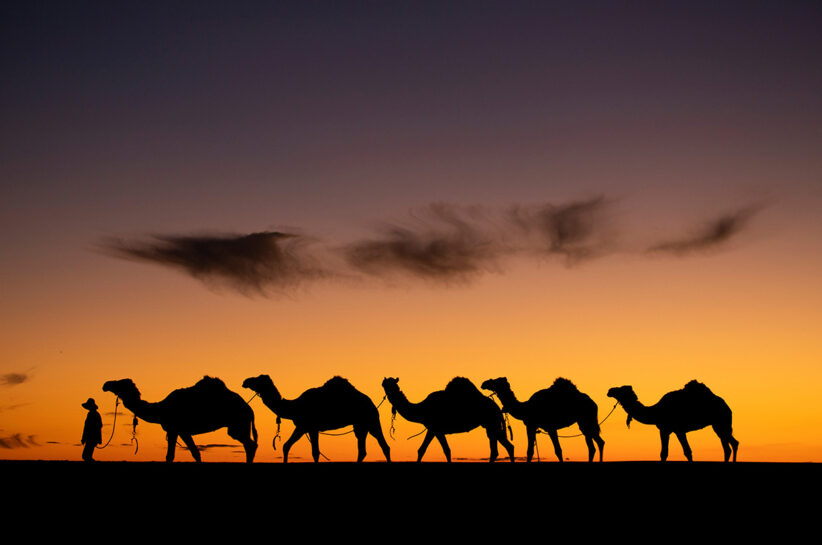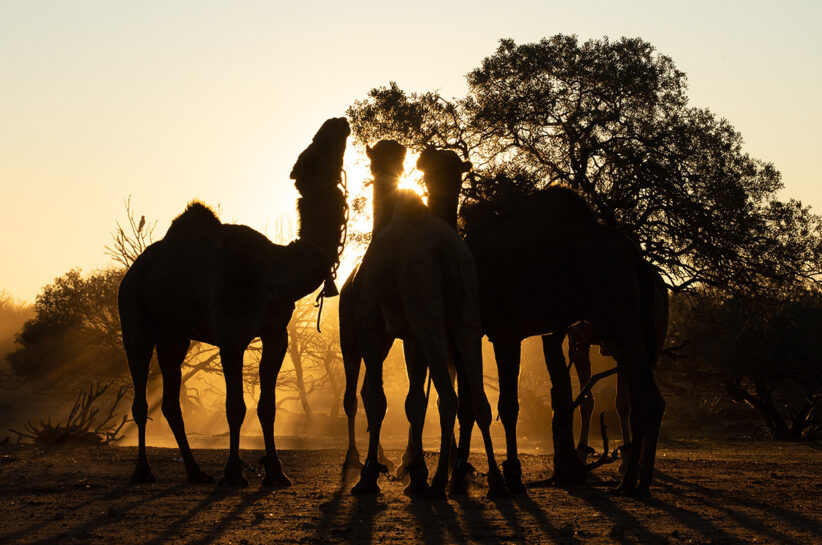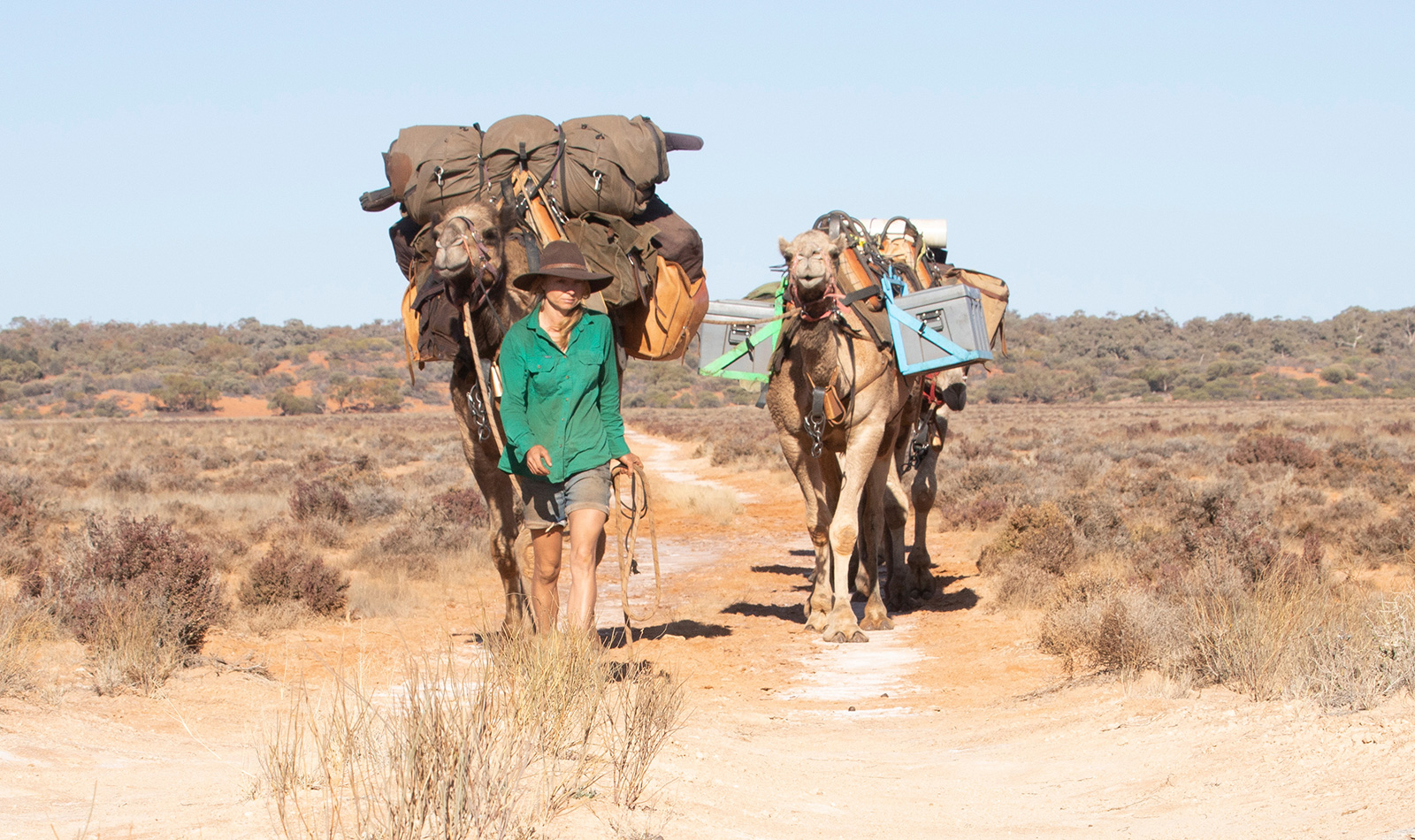In the Company of Camels
Words & Photography by Sophie Matterson
The sudden clanging of the camels’ bells wakes me. I open my eyes in the black of night, fighting off the haze of sleep, struggling to remember the orientation of my camp. Where are my camels tied? I feel the cold barrel of the rifle resting against my body as I scramble for my head torch. Something has disturbed my five camels, making them all stand up in sudden fear. Before I can grasp a light I hear an unmistakable sound: a deep guttural burbling resonating through the night, eerily like the draining of a kitchen sink. Instantly I snap wide awake, grab the rifle, and leap up at a million miles an hour.
It’s a wild bull camel – not the first, and I know it won’t be the last. The bull will stop at nothing to get to my camels and I am the only one who can stop him. I curse the darkness. I wish I wasn’t so tired. That I could have been more prepared. That I wasn’t alone. But it’s just me, my camels, and the bull in the middle of the vast night of the Great Victoria Desert.
***
Several years ago I had been searching for a different direction in life, a sense of purpose and adventure. Through a series of what seem in hindsight like fortuitous events, I stumbled upon the world of camels. I quickly fell in love with these intelligent and enigmatic ships of the desert, and soon enough the expansiveness of the Australian Outback beckoned. Maybe it was my age, my upbringing, or simply a human desire to challenge myself and prove my worth that propelled me into the adventure – I don’t know. Somewhere during the proceeding years of learning to work with camels, I decided to set myself the lofty goal of walking across the width of Australia from the Indian Ocean to the Pacific: a journey of close to 3,000 miles with my five wild-caught camels.
Australia has roughly a quarter of a million feral camels roaming its arid interior. Imported by early explorers, these camels were later set free when motorised transport rendered them obsolete. Australia now has the only population of feral dromedary (one-humped) camels in the world, and our deserts have bred the healthiest and strongest of the species worldwide. For my trip, I knew that I would need this hardiness on my side, so. it always made sense to choose camels from this wild population. I was also keen to train my own camels, as I knew I could develop a greater bond with them – they would be blank canvases, untainted by previous bad handling. Camels mistreated by humans will harbour a lifelong grudge for our species.
Taking camels on this journey enabled me to be self-sufficient. I did not need a support crew to carry the water required to cross the desert, and camels are the only animal that can withstand such harsh terrain – being able to go days, if not weeks, without water. In the desert the camel is king. In winter the male camels come into rut, their breeding season, and fight with other male camels for breeding rights, sometimes causing severe injuries or even death. This was a huge threat to the safety of my camels. As I walked, I looked back at the five individual camel faces I had come to love and know so well. They were my responsibility, and I could not let anything hurt them. They were also my lifeline in the desert. If they were to take off or be injured, it would jeopardise my safety.
I had left the spectacularly beautiful coast of Shark Bay, Western Australia, several months before. Painstakingly slowly, at the average camel speed of 2mph, I plodded my way into Australia’s arid interior with my caravan of five camels: Jude, Delilah, Charlie, Clayton, and Mac. From the beginning it was harder than anticipated. My daily schedule worked around the need to graze my animals. Every afternoon we would finish several hours before sunset, so that I could hobble the camels and allow them to graze. In theory, hobbles should stop your camels from wondering far from camp. In practice, if the camels decided that I had placed our camp in an unsuitable spot, they would shuffle off amazingly quickly to greener pastures on the other side of a sand dune or patch of bush.



It was infuriating and tiring. After walking for most of a day with the camels, I would have to spend around an hour unloading the gear off their backs. I would then release them in their hobbles to graze, and soon enough I would be back on my feet again, tracking them so they didn’t disappear into the bush, never to be seen again.
From day one I established a strict protocol: when arriving at camp, I would set a GPS waypoint as well as always carrying the GPS on me while tracking the camels. One day I was leading the camels back to camp through some thick scrub in what I thought to be the right direction. An hour later I still hadn’t found my equipment, and when I finally stopped to check my GPS I was horrified to see that I had walked in the wrong direction and become totally disorientated. That experience rattled my confidence and often made me second-guess my sense of direction.
At times, opportunities to stay at station homesteads relieved the exhaustion of the first couple of months. At these large farmhouses I would finally be able to attend to my own needs, rather than having to babysit my camels around the clock. However, as I neared the Great Victoria Desert, Australia’s largest desert, spanning 163,115 square miles, these resting points became scarce. I had decided to take a track across the desert called the Anne Beadell Highway – a rough-as-guts outback four-wheel-drive track traversing 823 miles of waterless wilderness across Western Australia and deep into South Australia.
In a normal year the track would see a car every second or third day. During the year I travelled, access was shut to all other traffic than myself, owing to the government’s attempts to restrict the spread of Covid-19 to Aboriginal communities. Covid meant I would be out there alone. It would be three months of travelling without a single yard to contain my camels for a day of rest. Like walking the length of the UK, from the southern tip of England to the north of Scotland, without passing through a single town.
But what worried me the most was not the remoteness. It was the wild bull camels.
***
I was bouncing about in the passenger seat of a Toyota LandCruiser Ute. My gaze kept returning to the large rifle on the dash in front of me. I had just arrived at Nambi Station for a couple of days’ rest, and Craig the caretaker was showing me the track that I would be taking with my camels in the coming days. ‘Over here is where I saw that mob of 20 wild camels the other week. I managed to shoot four before the herd took off.’ He passed me his phone with some graphic photos. Craig happened to come from an ex-military background, so handling a rifle was nothing new to him. ‘Part of my job out here is to keep all the feral species under control. I take photos of what I kill, and it gets logged with the DPI.’ The Department of Primary Industries classes camels as a feral species; landowners are required to cull them because of the environmental damage they’re suspected to cause. The Ute came to a stop in a cloud of red dust and we jumped out. ‘While we’re out here, let’s practise what I taught you,’ Craig said, grabbing the rifle on the dash.
When I had arrived at the station a couple of days back, Craig had instantly spotted the rifle rolled up in my swag. ‘Good, you’re carrying a gun – you’re going to need that.’ But his face dropped when I pulled the gun out to show him. Someone had advised me to take off the scope. Without it there was no sight to help me aim. ‘How are you meant to shoot anything without a scope?’ he said, and I felt like a total amateur.



I hated this cumbersome lump of metal and was so scared of its power that I had avoided practising. I knew the situation would arise where I would have to use it, but I had avoided thinking about that, hoping blindly that everything would be all right. In the days that followed, Craig taught me – with military precision – everything I would need to know. He taught me how to shoot accurately, where to aim, how to breathe, how to stabilise the gun, how to check if an animal was dead. Without Craig I would have been toast. I was now ready in a practical sense, but I still wondered how I would feel about killing an animal I had such an affinity for. Would I have the guts to pull the trigger and protect my herd?
***
My first encounter with a wild camel happened during my long crossing of the Great Victoria Desert.
The hair on the back of my neck stood up as I gazed down at the print of a large camel pad in the red sand. I knew it had not been made by one of my own. Knowing that they could be anywhere was an eerie feeling; I was constantly trying to assess the age of footprints and droppings, trying to determine how close they might be. My camels could smell them, too. My caravan was mostly made up of young males who didn’t stand a chance against the muscled and dominant specimens in the wild. At camp my camels were even more edgy, wanting to escape a sense of danger, and moved further away in their hobbles. I took to carrying the gun everywhere with me – on my shoulder while they grazed, sleeping with it at night. The need for constant vigilance exhausted me.
Dusk. I was collecting my camels to bring them back to camp when I heard an unmistakable sound: the burble made by a bull camel as it blows out its dulla: a bullfrog-like sack that is inflated and hangs out of the mouth when the male is in rut and ready for a fight. I had wanted to prove my self-sufficiency on this trip and now this was it. No-one was here to help me; I had to do this on my own.
I quickly tied my camels to a nearby shrub and grabbed the rifle with shaking hands, then ran to camp and collected a water jerrycan that I could rest the gun upon and stabilise my shot. As if in slow motion, the bull emerged from a line of trees – a huge hulking shape, swaggering, burbling, frothing at the mouth, the biggest and most muscly camel I’d ever seen. Time sped up again as he started trotting towards my camels, fixated on them, and I knew I had to take the shot. I squeezed the trigger but he kept coming. I reloaded and fired again, not even hearing the sound of my .308 rifle over the thundering of my heart. The second shot pulled him up and he fell.
In a panic I fired several more shots, but the second had already done what was necessary. With caution I approached the body of the 2,000lb bull, a hairy shape slumped in the dust, and placed my index finger on his motionless eyeball to check if he blinked. There was no reflex. He was dead. It had always been my fear that I might injure one of these spectacular creatures and it would run away dying a slow and painful death in the bush. I stood over the carcass feeling numb. The thumping of my heart was replaced by the ringing in my ears from the gun. The next day I woke early and saddled quickly in the dark in order to leave the bloodied scene of the previous evening behind.



In the weeks that followed I recognised that something was shifting in me. A tough determination was mounting that mirrored the harshness of my environment. But the Outback is full of polarity. The sun-bleached land would fade away in the evenings to be replaced by the pastel hues of sunset, merging into the red sand. At times I would perch on a dune watching the camels graze peacefully. Life may be tough out there, but it was also simple, and I felt an immense sense of peace in this vast wilderness that I don’t think can be matched in any other environment. It was pure, wild, and beautiful.
I saw many other wild camels on my travels. Some posed a threat, some I was able to scare away, and some did not threaten us at all. I was able to marvel at them – creatures free to wander these vast uninhabited stretches, able to survive where other large animals could not. My own team of camels had become like family to me, although there was a lingering guilt that I had taken them far away from their own wild homeland. I knew, on the other hand, that they had been part of a larger herd mustered from the wild for camel meat. My camels had been given a lucky second chance.
***
Where is the bull? I think as my head torch shines out into the dark of night. I grip my rifle tightly. There’s a horrible feeling in the pit of my stomach that I might have to make another kill.
Then my light catches the shape of a small and spindly pair of fluffy legs – a far smaller figure than I had expected. I know I heard a bull in the darkness, but there is also a baby camel in this group. I allow myself a relieved sigh. Through multiple encounters with these wild animals, I’m confident that I will be able to deal with this situation peacefully. I had only ever had to use the rifle on solitary bulls who would not take no for an answer. This situation can be resolved without bloodshed.
I scream and hoot like a banshee or a wild woman, flailing my arms about as I run at the night-time intruders. The females, hidden by the darkness until now, take one look at me and spook, along with the baby in their midst – and the bull, seeing his girls swiftly departing, takes off after them. I listen to the sound of their feet softly thudding away down the track.
It’s over. I walk to my camels and place my hand on the side of Jude’s powerful neck, leaning into him, connecting my face with his, gently breathing into his nostrils as a way of communicating that things are OK. He relaxes and I hear the soft movement of Delilah next to him, sitting down to resume her sleep. My herd feels safe.
The next day my five camels and I set off down the road following the tiny footprints of the little baby camel. It seems that we are following a highway for camels rather than cars; I have not seen a vehicle track in weeks. I might be the only person on Earth. I feel independent, wild, and free.
First published in Sidetracked Volume 23
Sophie Matterson and her camels, Jude, Delilah, Charlie, Clayton, and Mac, completed their 3,000-mile journey across Australia in December 2021 when they reached the Pacific Ocean at Byron Bay. They walked for 13 months.
sophiematterson.com // @sophiematterson



